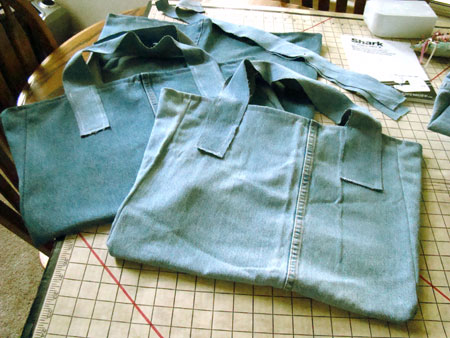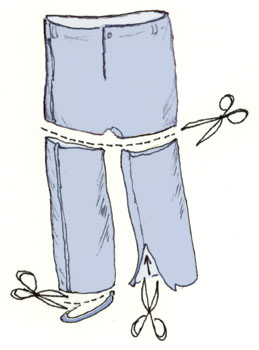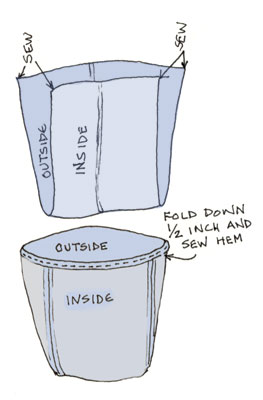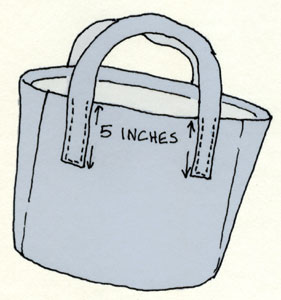
Driving along the highways of California in the next few weeks, I can look forward to seeing orange poppies bursting into bloom among purple and yellow lupines, pink mallows and yellow and white mustards. What I don't look forward to are what I see far much more of: plastic grocery bags, some whole, some in shreds, dotting and dusting the grasses and roadsides everywhere I look.
I see them blowing down the street towards the river on garbage pickup day, when the wind has gusted them away from the garbage truck. I've had to dip them out of our swimming pool, and our fish pond after they've blown over the fence from the neighbor's. They clot the edges of the river, and peek out of the wild blackberry thickets in the woods. They hang from fences, and cluster in the corners of parking lots.
The first time a jar of jelly slithered from a slippery plastic bag in the parking lot of the supermarket and smashed at my feet, I decided that I hated plastic bags with a passion. That would have been twenty years ago or so, and my antagonism at them has only increased.
They collect in the pantry in gobs. They degrade enough, in time, to be flimsily useless, but not enough to disappear from the earth. Most of them have enough holes in them by the time you get them home from the store to be unfit for a second career. They are a major pollution problem across the whole world.
Yet the baggers at the grocery have a love affair with them. They ask, "Paper or plastic?" and yet even if you have expressed a desire for paper, they will find ways to slip plastic bags into the order. Two cakes of soap get wrapped in an entire plastic bag. The dishwasher detergent powder is stuffed into a single plastic bag before being placed in the paper bag, in spite of the harsh edges of the box tearing the plastic open even before the bag is unpacked. Any meat, any frozen item gets its own garment of plastic. Indeed, most of the baggers I encounter these days simply say, "Is plastic all right for you?" in a hopeful voice, as though asking for paper bags will be an inconvenience to all.
Because of the flimsy nature of the bags, fewer items can be packed into them than into a paper shopping bag. A grocery order that requires four paper bags ends up being put into eight to ten plastic bags, most of which slither around the back of my van as I drive home, and fall out when I open the rear door, due to the slight hill that contains my driveway.
Paper bags I re-use for waste containers, for collecting other paper items to recycle, for playing with the cat or the dog or the grandchild. However, a paper bag caught in a hedge will eventually melt into mulch even if it doesn't get recycled in the paper bin; a plastic one will not.
Our new grocery store in town has a collection point for plastic bags to be recycled. I admire them for providing that. But I still object to the manufacture and proliferation of plastic bags.
Since I began recycling paper a couple years ago, as well as plastics and glass, the household output of "trash" reduced BY HALF. That's a lot of garbage. What if every household did that? Think of it. Needing HALF the landfills! And having followed that train of thought, I wondered how to get around even needing to collect all those paper grocery bags and take them to the recyclers.
The answer came to me as I was pack-ratting denim blue jeans, the seats of which were worn through to a state of embarrassment. It shouldn't be all that difficult to make a durable, washable grocery bag out of the legs of denim pants. And in point of fact, it isn't. That it took me nearly four years to get around to actually doing so is not a point in my favor, but this past weekend, I made it a goal to drag out the collection of pants and strike a blow for living "green."
This is how it is done:

Cut the pants legs away from the rest of the pants.
Cut the weaker inside seam away.
Cut off the seam of the cuff. We cut off the seams because they are bulky bits our sewing machines will not want to deal with. I have known otherwise dependable sewing machines to go on strike and walk out of the house when asked to sew over blue jean seams.

Fold the bottom of the split leg to the top, inside out; even the top line if necessary.
Sew the sides together, top to bottom; don't worry if one side is wider than the other -- that just makes it more basket-like. Fold down a half inch along the top to make a hem and sew that.
Cut two denim strips about 2 1/2 inches wide by 27 inches long.

I sewed a line of stitching 1/4 inch away from each edge of the strips; these will be the handles, and I wanted to be able to stop the raw edges of the denim from raveling. Certainly I could have made the strips wider, turned the edges under and made proper hems on all sides, but my cheapie sewing machine hasn't that much power, I haven't that much patience, and we're talking grocery bags here, not red carpet accessories.

Attach the handles to the bag, giving them five inches of attachment for strength. I tested the prototype with a full large box of doggie treats, a small sack of apples, a box of tea, some canned goods from the pantry -- and the handles held, at that point secured only by four dressmaker's pins. Sewn onto the body of the bag, the handles could easily safely carry a watermelon.
I made four of the bags in an afternoon. They will take the place of six to eight paper grocery bags easily; probably take the place of ten or twelve plastic bags.
There's not a lot a single person can do to help reduce the waste of resources in the world, but every teensy bit helps.
And I have to say, the look on the bagger's face the first time I took the bags to the store was quite rewarding. "Wow, dude, you made this? Wowwww!"
Heh.

The Piker Press moderates all comments.
Click here for the commenting policy.